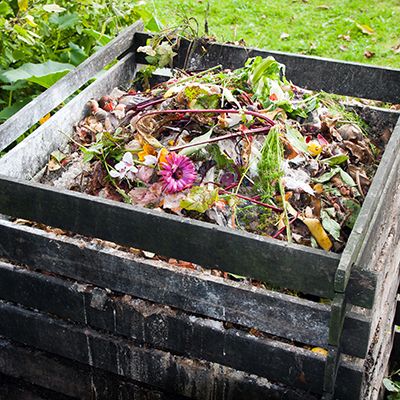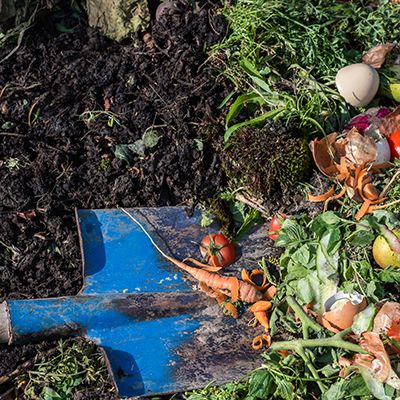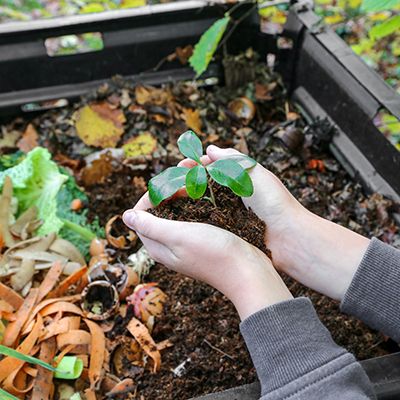


Composting
To make our heavy clay and adobe soils more workable, a considerable amount of organic matter in the form of decomposed plant material must be mixed into the top eight to ten inches of the clay soil. The organic matter continues to decompose when it is mixed with the clay and moves in between the clay particles forming a looser, friable mixture. A good workable recipe is to scatter ten pounds of gypsum per 100 square feet, Master Nursery® Master Start Fertilizer at two pounds per 100 square feet, and two or three inches of organic matter over the entire area. All of the ingredients are then rototilled or dug down to a depth of eight to ten inches. The gypsum acts chemically with the clay to help separate the particles. The fertilizer provides extra nitrogen to help the soil microbes break down the organic matter.
The organic matter can be purchased in bulk or bags such as Master Nursery® Gold Rush and spread out as needed. The home gardener can make his/her own organic material in the form of compost. Compost in its simplest form is merely partially decayed vegetation. When leaves, grasses, twigs and such decompose normally in the forest, we call it humus and it gradually mixes into the upper layers of existing soil. This is what we wish to duplicate in our home gardens.
Home composting can range from an ultra-simple to a highly refined procedure. The ultra-simple procedure consists of accumulating all the household and garden plant materials in a vacant corner of the back yard. Leaves, pine needles, small twigs, grass clippings, weeds, vegetable discards, and even egg shells are all placed in a pile. A bit of garden soil is scattered on the pile occasionally to provide the microbes needed to do the decomposing. If the pile is left alone, it will take one or two years for all of the ingredients to decompose to a useable size. Material is constantly added to the top and removed from the bottom. With a bit of help such as stirring the pile every week or two and sprinkling a spray of water on the pile, the time can be cut to four to six months.
The finished compost can be added directly to the soil or collected and stored until there is enough to treat a large area. Adding a little at a time to the surface as mulch is a valuable procedure because the compost will gradually find its way into the soil.
For those gardeners who wish to speed up their composting you will need from one to three bins. The bin should be about three feet by three feet by three feet. If you plan to include a lot of fruit and vegetable material in your compost pile, the bin will have to be made rodent resistant with a lid, floor and no holes larger than one-quarter inch.
The material going into the bin should be an approximately equal mixture of greens (grass clippings, food scraps, young weeds, manures) and browns (dry leaves, twigs, newspaper, sawdust and other dry woody material). If possible, alternate greens and brown with a small shovel full of topsoil or recently completed compost added to the first layer. This shovel full of material will provide the microorganisms needed to decompose the plant material.
When food trimmings (vegetable parts, citrus rinds, apple peels, egg shells, etc.) are added to the compost pile, they should be placed in the center, covered and again stirred vigorously. Under no circumstances should meat, bones, fish, dairy products, grease, grains or beans be included in the compost pile. When the bin is filled, it’s time to start another bin.
For people with three bins; when the first bin is filled and partly decomposed the material is transferred to the second bin and treated as it was in the first bin. When the material in the second bin has finished composting, it is transferred to the third bin for storage. The compost may be sifted with a one-half inch hardware cloth strainer or just dumped unsifted into the third bin. The compost in the third bin is ready to use as an amendment in the heavy clay soil or as mulch around existing plants.
If your three by three by three bins are properly aerated and moisturized, you can expect the microbes to generate enough heat to raise the temperature to 140°F. This temperature will kill many weed seeds and harmful microorganisms but not all. Therefore, do not put mature weeds or diseased plants in your compost pile. Additionally, cat and dog feces or saw dust from plywood or chemically treated wood must not be included in your compost pile. Don’t plan to add worms to your compost pile unless it’s the ultra-simple type because the high temperature will cook them!
Some of the other acceptable materials for addition to the compost pile are pine needles and most saw dusts (browns) and tea bags, coffee grounds and filters, herbivore manures and banana peels (greens).
Occasionally, problems may develop in the compost pile. If it just is not composting, the pile may be too dry or have too much brown matter. When the pile smells rotten or attracts flies, it may be too wet, have too many food scraps or too many lawn clippings. Non-compost items such as meat, grease, dairy products, and cat or dog feces, will also cause your pile to smell rotten. Most of these problems are easily remedied when you determine the cause.
Compost’s primary value is as a soil amendment or mulch. There is little fertilizer value in compost and it cannot be relied upon to be the sole nutrient source for the plants in your garden. There is some Nitrogen in the greens portion of the compost but most of that is used up by the microbes during their decomposition of the brown. Since the compost is used primarily to improve the texture of the soil, fertilizers must be used on a regular basis to maintain the fertility of the soil. This is especially true in vegetable gardens where produce is continuously being removed.
Compost teas are often credited with having almost magical values for stimulating plant growth based largely on anecdotal evidence. Thus far, there has been little or no tested evidence to substantiate these claims. Unfortunately, there have been cases of bacterial diseases (salmonella, etc.) reported from the use or preparation of compost teas. Therefore, it is recommended that rubber gloves be worn whenever the gardener comes in contact with compost tea.
There is, however, ample scientific evidence to support the successful beneficial use of composts in both adobe and sandy soils.
For those gardeners who are only interested in composting table scraps or have little other material available, there is another very simple composting procedure. Simply dig a hole in the ground about a foot in diameter and 12 to 18 inches deep. Once a week or as needed, drop the vegetable table scraps in the hole and sprinkle a couple of tablespoons of soil over the top. Citrus and banana peels and cantaloupe rinds are going to take longer to decompose so cut them into smaller pieces. If you are really in a rush, run them through the blender first.
What happens if your hole in the ground compost bin fills up? Start another hole next to the first one and as that one fills, the material in the first hole becomes ready to use. Cover the hole with a board or an old trash can lid.
Don’t compost your grass clippings. Grass-cycle them! Leave them on the lawn to decompose where they will add nitrogen and other minerals and reduce fertilizer use by up to 30%.